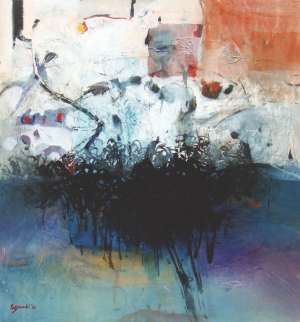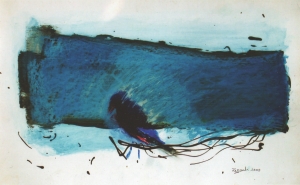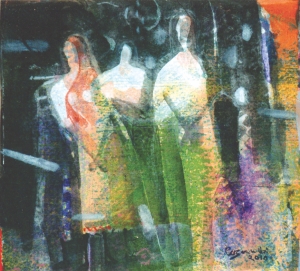| Home - Back Issues - The Team - Contact Us |
 |
| Volume 10 |Issue 44 | November 25, 2011 | |
|
|
Art The Romantic Fayza Haq
Rezaun Nabi is an artist who believes in preserving nature, as all artists of the twentieth and twenty- first centuries do in the Subcontinent. With nature being destroyed in the name of industrial progress, and the natural consequences of which is the country's population moving to the urban area in quest of employment, it is important to save nature with its beauty and usefulness for the health of flora and fauna. The trees, with their flowers leaves, fruits, grass; expanses of waterways with fish and birds are mindlessly being destroyed unscrupulously. Trees are felled, and rubbish like polythene and kitchen garbage are being dumped in rivers the Ganges, Shitalakhya and Padma. Along with the inevitable and ceaseless noise pollution, there is the emission of black smoke, from the vehicles and factory chimneys and brick kilns – even in places like Chittagong, loved for its greenery and closeness to the sea. Dhaka and other mega cities of Bangladesh are gradually losing its trees and waterways. Thinking artists, like Rezaun Nabi, whose works dwell on the ill effects of the race towards modernisation, in the name of industrial growth. Rezaun Nabi, originating from North Bengal–that is from the banks of the River Padma– paints of the glory, beauty and harmony of the tiny hilly backdrop with the cultivation that took place in his youth. The golden paddy fields, the kingfisher, the beautiful exotic blossoms, the golden paddy and mustard fields—these are elements which Rabindranath Tagore and many other poets who followed him, like Jibanananda Das, Michael Madhusudan Dutt, Jasimuddin, and Shukumar Rai—dwelt on. So did many creative individuals like song-writers, and thinkers from time immemorial. It is not only the Romantic poets like Wordsworth, Keats and Shelley, and later Frost and Whitman, who sang of the wonderful nature around them. Later, with the advent of World War II and its madness, philosophers like Nietzsche believed that mankind's only hope in the modern world was the essential return to nature. For mankind, nature remains the healing fountain of life. Even in the time of Adam and Eve, “Adam delved and Eve span.” In the Neo- colonial days, it is elements like the windmill in Holland, as Rezaun Nabi says, that is being preserved for mankind's future. Such preservation of the use of nature should be there in our countries too, says the forty-five-year old artist, Rezaun Nabi, who has brought in nature, in his innumerable paintings, seen here and overseas. In his illustration work for the UNDP, which includes his regular income, Nabi has brought in the importance of water, and other natural elements. Something, like the wind, which is certainly difficult and near impossible to illustrate on paper, has been done in the past by this nature loving artist. The global warming is a worrying preoccupation of many sensitive artists – whether s/he is from Sydney or South India.
Creative people, like Rezaun Nabi, feel its imminent that artists today should hold up the image of elements like the nightingale on the trees, the glow worm in the skies, the moon adrift, the sunshine filtering in through the clouds, the play of light and shade during all the six seasons of Bengal. Not only that, he has tried to capture the beauty of the countryside during sunset and midday. Rembrandt, in Holland, where the artist has studied for several months, is a maestro of chiaroscuro, like Holbien– and other Dutch and Spanish master artists, like Goya. Nabi also talks of the Santals in North Bengal with their “air conditioned" mud huts packed with snail shells and broken brick bits– as stones are rare in that part of Bengal. The natural items are used, he says, along with paddy husks or “tush”. Talking of the beauty of waterways, like rivulets and rivers, along with green and gold fields laden with harvest. These are lined with date palm trees, and other items of fruit, that are laden with natural drinks, with bees and humming birds hovering nearby. The urban rejects, like skins of fruit and vegetable, and leftovers from the kitchen and garden markets, along with animal litter choke our water bodies. They create the imbalance below the earth, and cause the repeated earthquakes, says Rezunnabi. He would like to get the aerial view of the rural areas of North Bengal, near the banks of the Padma with all their variations and undulations. The other side of Bengal, West Bengal that is, has the same topography. This was noticed by all artists, and serious art lovers –who visited the Bengal Gallery recently—with prints from across the border—which were so similar to that of pioneer print-maker, Safiuddin Ahmed's prints, with donkeys, trees, dogs; men with umbrellas – to keep off the strong sunshine interspersed with the occasional raindrops,that keep falling on the heads of farmers. His theme over the years has always been nature, with man being a part of it. Birds and animals are also naturally included. This goes along with fish, when fishermen are delineated. These are usually not realistic, but semi–abstract and stylised. When doing book illustrations – which have been the source of his steady income– these have been realistic with forms and images – in order to elaborate on the text and decorate the passages of prose or poetry. The reason, says Rezaun Nabi—whose father, incidentally, also painted, being a self-taught artist. We focus on various elements of nature, says this artist, with innumerable paintings to his credit. A photographer sees this in one way and a painter another–- in different colours and compositions. His solo exhibition to be held in the near future at Dhaka Art Centre, Dhanmondi will be in water-colour. Some of his outdoor work will be very realistic and academic. However, some of them will be semi-abstract too. He tries to portray the different forms of nature in different seasons through his washes, lines, curves and dots. For instance, says the artist, the chrome yellow of the flowers of the mango tree, before the fruits ripen, has been captured in his last exhibition at Bengal Gallery, in the recent past. Rezaun Nabi has had six solo exhibitions, two in Australia and the Netherlands. His Sunderbans joint exhibit, along with 18 other artists at “Chitrak”, in the recent past, also caught every viewer's attention. His job related work at “Proshika” includes designing and being in charge of publication. He works for other national and international NGOs, which involves illustration for books aiming at children's education. These include over 250 books, each book containing 40 to 50 drawing. Going back to the subject of nature, Rezaun Nabi says that this business of man using nature, and nature in turn being preserved by man, is a subject he wishes to bring repeatedly in his work. This is to highlight the importance of nature, and arresting the rampant cutting down of trees to build homes, schools, workplaces, roads, factories etc. It is vital to stop the filling up of waterways in the name of development, he says repeatedly to drive the point home. Man is making money at the cost of nature, he laments.
Copyright
(R) thedailystar.net 2011 |


